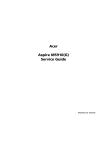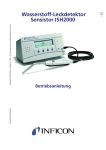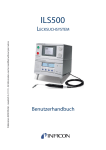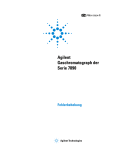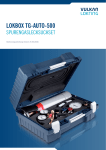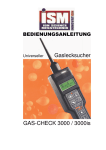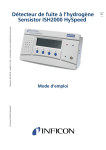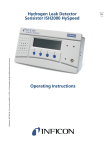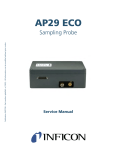Download AP57 Counter Flow Probe
Transcript
Publication: INFICON AB - ning69e2-a (1108) - All information can be modified without prior notice AP57 C OUNTER F LOW P ROBE User’s manual Benutzerhandbuch AP57 C OUNTER F LOW P ROBE User’s manual EN Contents 2 1.1. General .......................................................................................................................................... 3 1.2. Main parts ..................................................................................................................................... 3 1.3. Installation ..................................................................................................................................... 4 1.4. Controls and Indicators ................................................................................................................. 4 1.5. Operating the AP57. ...................................................................................................................... 5 1.6. Troube shooting ............................................................................................................................ 7 1.7. Pneumatic and electric diagram .................................................................................................... 8 1.8. Technical specification.................................................................................................................. 9 INFICON – User’s manual AP57 EN AP57 Counter Flow Probe 1.1. General AP57 is an accessory to INFICON Hydrogen Leak Detector Sensistor ISH2000 that can be used instead of the standard Hand Probe H50. The AP57 probe is meant to be used on objects were excessive leaks could be suspected, or in areas were tracer gas not easily could be ventilated away. AP57 features: • • • • • Locates micro leaks in extremely high backgrounds. Pinpoints leaks in confined spaces and cavities. Locates a micro leak only millimetres away from a gross leak. Switching between two separately adjustable flows could be done from the hand probe. Leak alarm and Flow ON indicators in the probe handle. The tip diameter of the standard probe (H50) is 8mm. This is sometimes too big to allow leak detection in constricted areas. The solution to this is to have a sniffing probe with a long narrow tube at its end. SAFETY! Pure hydrogen is a flammable gas. Only use ready-made mixtures of 5% Hydrogen in Nitrogen. This is a standard industrial gas mixture used in various industrial applications. Whenever the word Hydrogen is used throughout this manual it implies that the hydrogen gas is safely mixed with Nitrogen in the proportions 5% H 2 - 95% N 2 Never use pure Hydrogen for leak testing! A typical application is leak location on combustion engines rejected by a previous pressure decay test. To be able to utilise all the functions of the instrument, read this guide and the Hydrogen Leak Detector Sensistor ISH2000 user manual carefully, before using the equipment. The Sensistor ISH2000 detector has two main functions: Detection Mode and Analysis Mode. Used together with an AP57 the Sensistor ISH2000 should be in the detection mode. Detection mode is used to quickly detect and locate a leak. In Detection Mode, the signal is shown as a moving bar and as an audio signal. The frequency of the audio signal directly reflects the gas concentration, which allows the user to work without having visual contact with the display. For gas concentrations equal to or above the set LEAK ALARM level a red LED indicator will illuminate both on the hand probe and on the AP57 front panel. 1.2. Main parts Control Box APC57 Hand Probe H55 Fluid Cable FC21 Signal Cable C21S 0,3m Bus Cable BC15 INFICON – User’s manual AP57 3 EN 1.3. Installation Important! CAUTION! The 25-pin D-type connector on the back of the Leak Detector is not a computer or printer port. Connecting a printer or any other computer device may cause permanent damage to the connected device. Always switch power off before disconnecting or connecting any cable. • Always connect the probe and the cables before starting the instrument. • Never pull out the probe cable when the instrument is in operation. • Never put the probe in water or any other liquid. 1.4. Controls and Indicators 2 5 3 1 Follow the instruction below to connect the AP57 system to the Sensistor ISH2000 Leak Detector. Connecting Sensistor ISH2000 and probe: 1. Place the controller (APC57) on a flat surface. Put the detector (Sensistor ISH2000) on top of the controller. 2. Connect the bus cable (BC15) between the 25pin D-type ports on the back of the units. 3. Connect the sensor cable (C21) between the corresponding connectors on the front of the units. 4. Connect the fluid cable (FC21) to the port on the front of the APC57. 5. Connect the hand probe (H55) to the fluid cable. 6. Connect a hose to the fresh air inlet on the back of the unit; the remote end of this hose should be placed in an environment free from tracer gas. 4 APC57 Control Box: 1) 2) 3) 4) 5) 6) Power On LED Counter Flow ON/OFF switch Flow A LED Flow B LED Flow A Throttle valve Flow B Throttle valve Hand Probe: 7) 8) 9) Accept Indicator (Green) Reject Indicator (Red) Push-button – toggles between Flow A and Flow B 8 7 9 4 INFICON – User’s manual AP57 6 EN 1.5. Operating the AP57. Application example: Truck engines in an engine production plant are leak tested in a pressure decay station. Leaking engines are diverted to a repair line where the leaks are located and repaired. Step by step locating procedure: Find a leak representing the smallest single leak you need to locate. (Alternately use a reference leak or throttle valve to set up the same flow). Charge the leak with tracer gas. • Start the Sensistor ISH2000 and set it in detection mode and sensitivity = 10. • Fully open (counter clockwise) flow throttle valve A on the APC57 panel. • Start the AP57 flow A and hold the probe tip right on the opening of the leak. • Close throttle valve A until the detector starts rising. • Open the throttle valve slightly until the signal starts falling again. Lock the set screw with the nut. You have now adjusted the AP57 probe so that Flow A will screen acceptable leaks, i.e. leaks that should not be repaired. Flow B can be used in to ways: 1) Either close flow throttle valve B fully. In this case you can use the switch on the handle to switch between no flow (B) and leak screening flow (A). 2) You can instead use flow B for suppressing very high backgrounds if that is a problem. In this case you should adjust flow B so that you can easily and precisely locate the leaks you need to locate. 3) For highest possible sensitivity you would then instead have to switch the flow off with the switch on the APC57 panel. INFICON – User’s manual AP57 5 EN Locating the leak: • • • First try to locate the leak with no counter flow in the probe. This gives highest sensitivity. If precise location is difficult switch flow A on, or if necessary switch on flow B and adjust the flow until signal is zero close to the suspect area. If counter flow is high you may need to put the tip of the probe right on the leak, flat on the surface to pick the leak up. Location will be very precise. Leak will be detected if within the rim of the probe tip and not detected if outside that rim. NOTE! Probe can be used with or without protective filter installed in tip. Flow adjustment is normally a bit easier if no filter is used! 6 INFICON – User’s manual AP57 Approx: 6 mm EN 1.6. Troube shooting Problem Probable cause Actions No signal when exposed to gas. Counter flow too high. Check that compressed air is within limits (4.5 – 8 bar) Sensor saturated. Check that exhaust line is not blocked. Any connected hose must have at least 4 mm inner diameter. Very long hoses should have larger diameter. Probe tip clogged Check white plastic probe tip protection filter. Remove the probe tip protection. Use a sharp pin or needle to remove the filter and check if alarm goes off. NOTE! Remember to install new protection filter. Tip protection filter part number:590-625 (500 pcs) Check condition of brass filter in tip. If clogged send probe to service. Check sample hose and probe tip for damage. Replace damaged parts. Sensitivity can not be adjusted by adjusting flow. Main flow switch is off. Set flow switch to ON No power to the APC57 Check that the Bus Cable is properly connected. controller Detector gives signal all the time. Pump is not running Check pump. Turn flow switch ON and OFF. You should be able to hear the pump start. Pump part number: T.B.D. Internal filter clogged. Open controller and inspect filter. Filter part number: 591-276 High background concentration of hydrogen. Increase counter flow. Improve ventilation Decrease tracer gas leakage from connectors etc. Detector gives signal every time flow is turned OFF High background of Hydrogen. This is normal in a high background. Flow should be on all the time when locating leaks in high hydrogen backgrounds. INFICON – User’s manual AP57 7 EN 1.7. 8 Pneumatic and electric diagram INFICON – User’s manual AP57 EN 1.8. Technical specification General Dimensions: 275 x 205 x 100 mm. Weight: 6 kg. Counter flow range: 0 – 33 atm cc/s. (2 separate flows) Probe tip diameter: ∅ 10 mm. Sensitivity: Flow off: 0.5 ppm H2 (equivalent to 0.2 g/y R134a). Adjustable (flow on): 0.5 ppm to “zero” sensitivity. Electric connectors: Fluid & Signal Cable: LEMO 10 pin female (mixed LV / pneumatic) Sensor Cable: LEMO 5 pin female Bus Cable: 25 pin D-sub female Fresh air connector: ISO G1/8” Supplies: Supply voltage: 24 VDC via Sensistor ISH2000 Hydrogen Leak Detector Fresh air: non hydrogen-contaminated air at atmospheric pressure INFICON – User’s manual AP57 9 EN Disposal of product when taken out of service. According to EU legislation, this product must be recovered for separation of materials and may not be disposed of as unsorted municipal waste. If you wish you can return this INFICON product to the manufacturer for recovery. The manufacturer has the right to refuse taking back products that are inadequately packaged and thereby presents safety and/or health risks to the staff. The manufacturer will not reimburse you for the shipping cost. Shipping address: INFICON AB Westmansgatan 49 582 16 Linköping Sweden 10 INFICON – User’s manual AP57 AP57 G EGENSTROM -M ESSKOPF Benutzerhandbuch DE Inhalt 2 1.1. Allgemeines .................................................................................................................................. 3 1.2. Hauptbestandteile .......................................................................................................................... 3 1.3. Installation ..................................................................................................................................... 4 1.4. Bedienelemente ............................................................................................................................. 4 1.5. Bedienung des AP57. .................................................................................................................... 5 1.6. Störungsbeseitigung ...................................................................................................................... 7 1.7. Schaltplan ...................................................................................................................................... 8 1.8. Technische Daten .......................................................................................................................... 9 INFICON – Benutzerhandbuch AP57 DE AP57 Gegenstrom-Messkopf 1.1. Allgemeines Der AP57 ist ein Zusatzgerät zum WasserstoffLecksucher Sensistor ISH2000, das anstelle des Hand-messkopfs H50 verwendet werden kann. Der Messkopf AP57 kann bei Objekten eingesetzt werden, bei denen große Lecks vermutet werden. Er kann außerdem in Bereichen verwendet werden, in denen Spurengas nur aufwändig abgeführt werden kann. Leistungsmerkmale des AP57: • Lokalisiert kleine Lecks auch bei extrem hohen Hintergrundkonzentrationen. • Spürt Lecks in umschlossenen Bereichen auf. • Lokalisiert kleine Lecks, die nur wenige Millimeter von einem großen Leck entfernt sind. • Die Umschaltung zwischen zwei getrennt voneinander einstellbaren Durchflussmengen kann über den Handmesskopf erfolgen. • Alarmpegel und Anzeige für aktivierten Durchfluss im Messkopfgriff. Eine typische Anwendung ist die Lecksuche an Verbrennungsmotoren, die während eines zuvor durchgeführten Druckabfalltests ausgesondert worden sind. Lesen Sie dieses Handbuch und das Benutzerhandbuch des Wasserstoff-Lecksuchers Sensistor ISH2000 aufmerksam durch, bevor Sie das Gerät in Betrieb nehmen, um alle Funktionen richtig nutzen zu können. Das Gerät (Sensistor ISH2000) hat Hauptfunktionen: Lecksuch-Modus und Analyse-Modus. zwei Beim Einsatz mit einem AP57 muss der Sensistor ISH2000 in den Lecksuch-Modus gesetzt werden. Der Lecksuch-Modus dient zum schnellen Aufspüren und genauen Lokalisieren von Lecks. Im Lecksuch-Modus wird das Signal in Form eines beweglichen Balkens dargestellt und als Audiosignal ausgegeben. Die Frequenz des Audiosignals gibt die Gaskonzentration direkt wieder, was das Arbeiten auch ohne visuellen Kontakt zur Anzeige ermöglicht. Bei Gaskonzentrationen, die den Alarmpegel erreichen oder übersteigen, leuchtet eine rote LED-Anzeige am Handmesskopf und an der Front des APC57. SICHERHEITSHINWEIS Reiner Wasserstoff ist ein brennbares Gas. Verwenden Sie ausschließlich fertig gemischtes Spurengas mit 5 % Wasserstoff in Stickstoff. Dieses standardmäßige industriell gemischte Gas findet in der Industrie vielerlei Anwendung. Immer wenn der Begriff Wasserstoff in diesem Handbuch verwendet wird, deutet es an, dass das Wasserstoffgas sicher mit Stickstoff im Verhältnis 5 % H2 - 95 % N2 gemischt wird. Verwenden Sie zur Lecksuche niemals reinen Wasserstoff! 1.2. Hauptbestandteile Steuerung APC57 Handmesskopf H55 Anschlussleitung FC21 Signal-kabel C21S 0,3m Bus-kabel BC15 INFICON – Benutzerhandbuch AP57 3 DE 1.3. Installation ACHTUNG! Die 25-pin sub-D Buchsen an der Rückseite des Lecksuchers und des APC57 sind weder ein Computer- noch ein Druckeranschluss. Das Anschließen eines Druckers oder eines Computers kann dauerhafte Schäden am angeschlossenen Gerät hervorrufen. Vor dem Abziehen oder Anschließen der Leitungen muss das Gerät unbedingt abgeschaltet werden. Um die Steuerung APC57 an den Lecksucher Sensistor ISH2000 anzuschließen, folgen Sie der nachstehenden Anleitung. Wichtig! Die 25-pin sub-D Buchsen an der Rückseite des Lecksuchers und des APC57 sind weder ein Computer- noch ein Druckeranschluss. Das Anschließen eines Druckers oder eines Computers kann dauerhafte Schäden am angeschlossenen Gerät hervorrufen. Vor dem Abziehen oder Anschließen der Leitungen muss das Gerät unbedingt abgeschaltet werden. 1.4. Bedienelemente 2 5 3 1 Anschließen von Sensistor ISH2000 und Messkopf: 1. Stellen Sie die Steuerung (APC57) auf eine glatte Oberfläche. Setzen Sie den Detektor (Sensistor ISH2000) auf die Steuerung. 2. Stecken Sie das Buskabel (BC15) in die jeweiligen 25-pin sub-D Buchsen an der Rückseite der Geräte. 3. Schließen Sie das Signalkabel (C21) an den entsprechenden Buchsen an der Vorderseite der Geräte an. 4. Stecken Sie die Anschlussleitung (FC21) in den Anschluss an der Vorderseite des APC57. 5. Verbinden Sie den Handmesskopf (H55) mit der Anschlussleitung. 6. Schließen Sie einen Schlauch an die Frischluftzufuhr an der Geräterückseite an. Das andere Ende dieses Schlauchs sollte sich in einer Umgebung befinden, in der kein Spurengas vorhanden ist. 1) 2) 3) 4) 5) 6) LED Gerät eingeschaltet Schalter Gegenstrom EIN/AUS LED Durchfluss A LED Durchfluss B Drosselventil Durchfluss A Drosselventil Durchfluss A Handmesskopf: 7) 8) Anzeige Durchfluss ein Alarmspegel-Anzeige 9) Taste (zur Umschaltung zwischen Durchfluss A und B) 9 INFICON – Benutzerhandbuch AP57 (Grün) (Rot) 8 7 4 4 APC57 Control Box: 6 DE 1.5. Bedienung des AP57. Anwendungsbeispiel: Lkw-Motoren in einem Motorenwerk werden mittels Druckabfallmessung einer Dichtheitsprüfung unterzogen. Motoren, bei denen Lecks auftreten, werden zu einem Reparaturband umgeleitet. Dort werden die Lecks lokalisiert und behoben. Sie haben den Messkopf AP57 jetzt so eingestellt, dass Durchfluss A tolerierbare Lecks, also Lecks, die nicht beseitigt werden müssen, anzeigt. Durchfluss B kann auf zwei verschiedene Weisen eingesetzt werden: 1) Schließen Sie das Drosselventil B vollständig. In diesem Fall können Sie mit dem Taster am Griff zwischen „Kein Durchfluss“ (B) und „Grenzdurchfluss“ (A) umschalten. 2) Alternativ können Sie sehr hohe Hintergrundkonzentrationen mit Hilfe von Durchfluss B unterdrücken, falls dies ein Problem sein sollte. In diesem Fall sollten Sie Durchfluss B so einstellen, dass Sie die Lecks, die Sie lokalisieren möchten, ganz einfach und präzise lokalisieren können. 3) Höchstmögliche Empfindlichkeit erzielen Sie, wenn Sie den Durchfluss mit dem Schalter an der Front des APC57 abschalten. Schrittweiser Lecksuchvorgang: Ermitteln Sie das kleinste Einzelleck, das Sie lokalisieren müssen. (Sie können auch ein Referenzleck oder Drosselventil verwenden, um den gleichen Durchfluss einzustellen.) Befüllen Sie das Leck mit Spurengas. • Starten Sie den Sensistor ISH2000, und schalten Sie in den Lecksuch-Modus und auf Empfindlichkeit = 10. • Öffnen (entgegen dem Uhrzeigersinn) Sie das Drosselventil A an der Front des APC57 vollständig. • Starten Sie den Durchfluss A des AP57, und halten Sie die Messkopfspitze direkt an das Leck. • Schließen Sie das Drosselventil A, bis ein Signal am Sensistor ISH2000 angezeigt wird. • Öffnen Sie das Drosselventil etwas, bis das Signal wieder abfällt. Fixieren Sie die Einstellschraube mit der Mutter. INFICON – Benutzerhandbuch AP57 5 DE Lokalisierung von Lecks: 6 • Versuchen Sie zuerst, das Leck ohne Gegenstrom zu lokalisieren. Dies gibt die höchste Empfindlichkeit. • Wenn eine präzise Lokalisierung schwierig ist, schalten Sie Durchfluss A ein. Bei Bedarf können Sie auch Durchfluss B einschalten und den Durchfluss so lange einstellen, bis das Signal in der Nähe des vermuteten Bereichs gegen Null geht. • Bei großem Gegenstrom müssen Sie die Messkopfspitze eventuell direkt an der Oberfläche flach auf das Leck setzen. Die Lokalisierung erfolgt dann sehr genau. Das Leck wird aufgespürt, wenn es sich innerhalb der Messkopfspitze befindet. Wenn es außerhalb liegt, wird es nicht erkannt. INFICON – Benutzerhandbuch AP57 Ca: 6 mm DE 1.6. Störungsbeseitigung Störung Ursache Gegenmaßnahme Kein Signal. Gegenstrom zu groß Gegens trom aus s c halten oder reduz ieren. Sensor gesättigt. Handm esskopf von Leck entfernen und ca. 30s warten. Messkopfspitze zugesetzt Messkopf zur Reparatur an INFICON senden Hauptschalter steht auf Off Schalter auf On stellen Buskabel nicht angeschlossen Überprüfen Sie ob die Power LED leuchtet. Falls nicht prüfen Sie das ob Buskabel zwischen APC57 und Sensistor ISH2000 korrekt angeschlossen ist. Pumpe läuft nicht Prüfen Sie die Pumpe. Sie sollten das Laufgeräusch hören können. Interner Filter zugesetzt Öffnen Sie das APC57 und prüfen Sie den Filter. (Bestellnr 591-276 ) Empfindlichkeit kann durch größeren Gegenstrom nich erhöt werden. INFICON – Benutzerhandbuch AP57 7 DE 1.7. 8 Schaltplan INFICON – Benutzerhandbuch AP57 DE 1.8. Technische Daten Versorgung Stromversorgung: 24 VDC (vom Lecksucher Sensistor ISH2000) Frischluft: Nicht-wasserstoffkontaminierte Luft unter atmosphärischem Druck. Anschlüsse. Frischluft: ISO G 1/4“ APC-Bus: 25-pin D-sub Buchse Signalkabel: 5-pin Buchse (Lemo-Stecker) Messkopfkabel: 10-pin Buchse (Lemo-Stecker) Leistung. Gegenstrom: 2 getrennt voneinander einstellbare Durchflüsse 0 - 17 ml/s bei atmosphärischem Druck. Gewicht: 6 kg Gesamtabmessungen: 100 x 275 x 205 mm INFICON – Benutzerhandbuch AP57 9 DE Entsorgung des Gerätes Gemäß geltender EU Gesetzgebung muss dieses Produkt einem Materialrecycling zugeführt werden und darf nicht in den kommunalen, unsortierten Müll entsorgt werden. Zur fachgerechten Entsorgung können Sie dieses INFICON Produkt an den Hersteller zurück schicken. Dieser hat das Recht die Annahme von Produkten, die nicht ordnungsgemäß verpackt sind und somit ein Sicherheits- bzw. Gesundheitsrisiko für die Mitarbeiter darstellen, zu verweigern. In diesem Fall wird Ihnen der Hersteller die Frachtkosten nicht erstatten. Lieferadresse: INFICON AB Westmansgatan 49 582 16 Linköping Schweden 10 INFICON – Benutzerhandbuch AP57 INFICON AB, Box 76, SE-581 02 Linköping, Sweden Phone: +46 (0) 13 35 59 00 Fax: +46 (0) 13 35 59 01 www.inficon.com E-mail: [email protected]


























